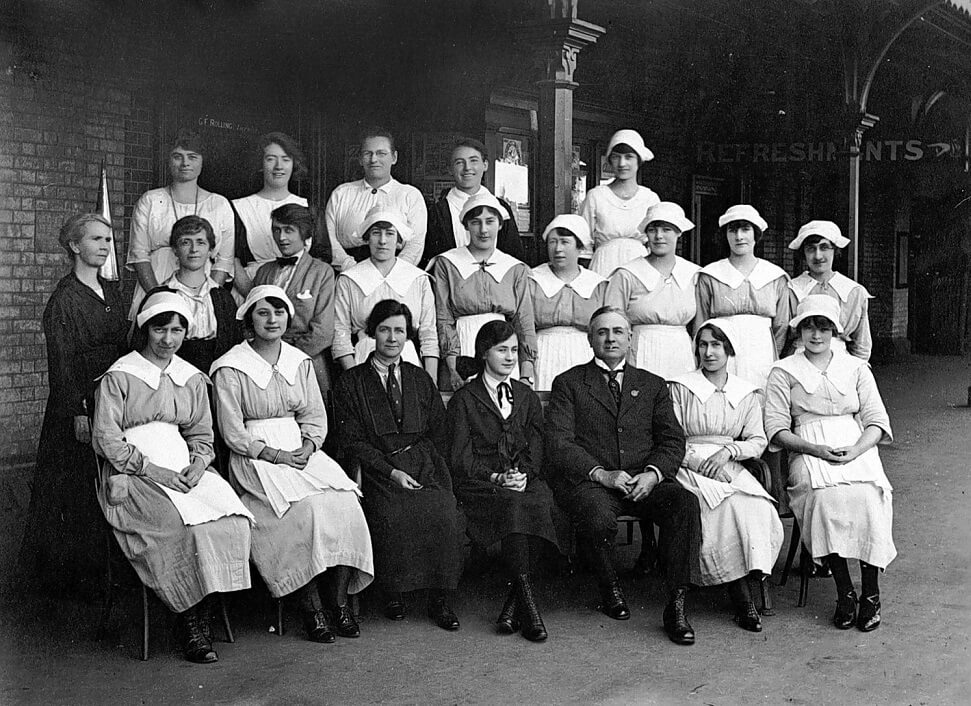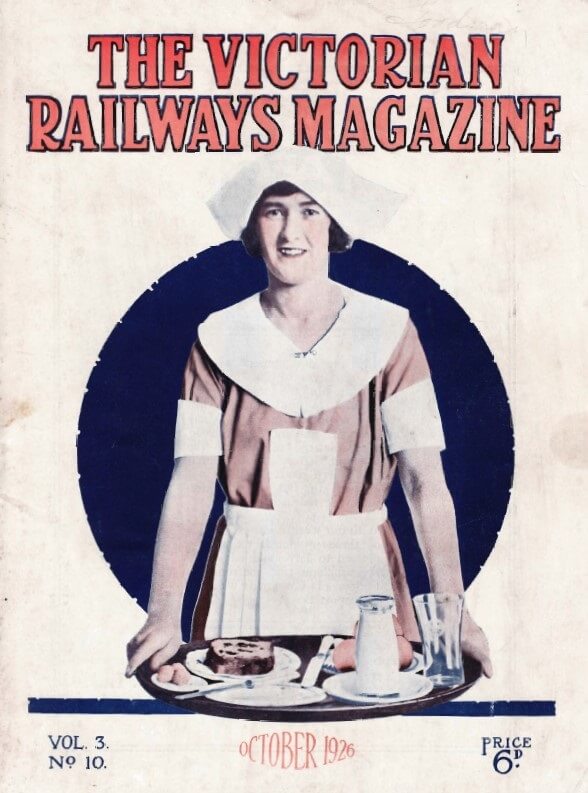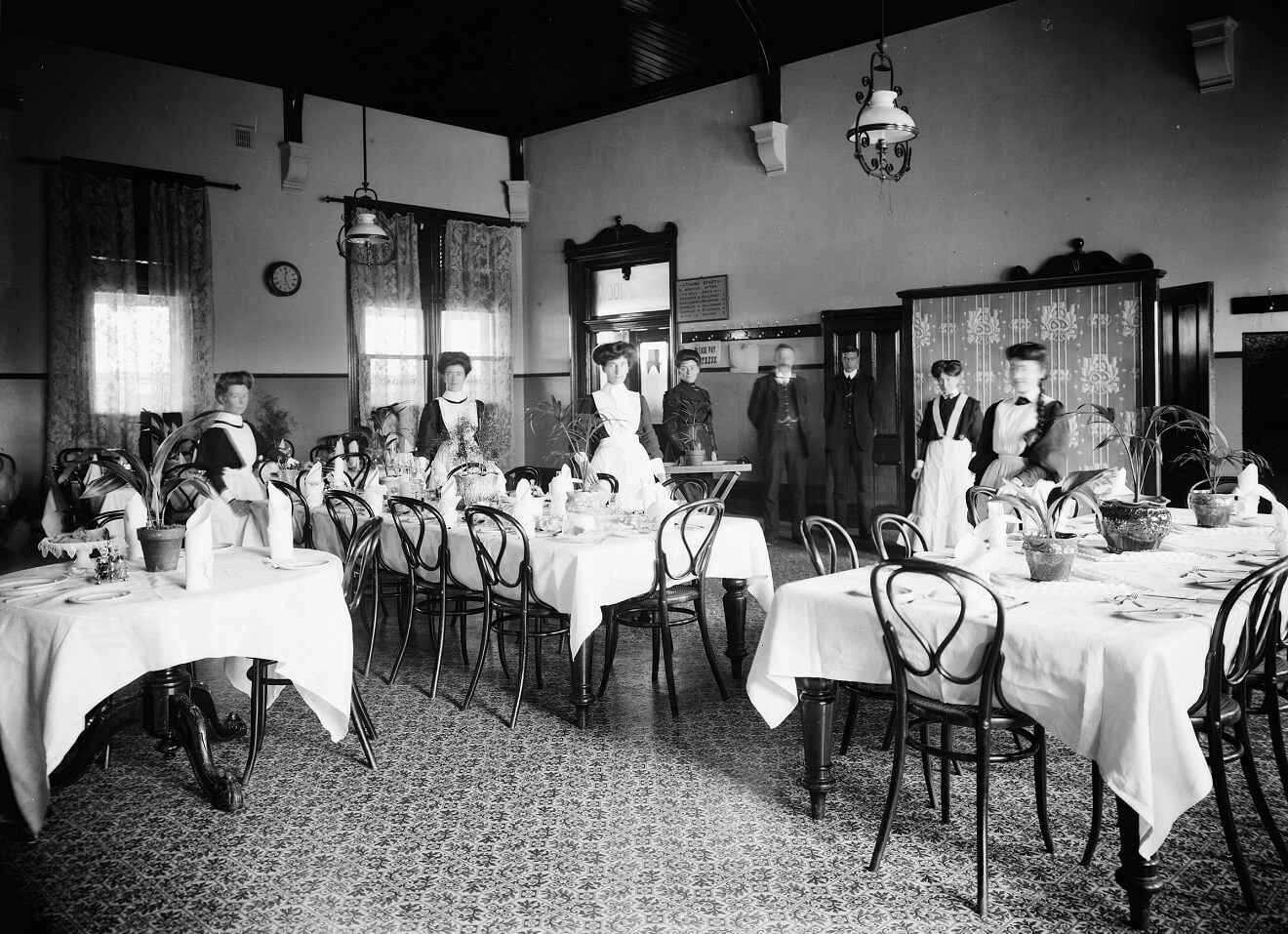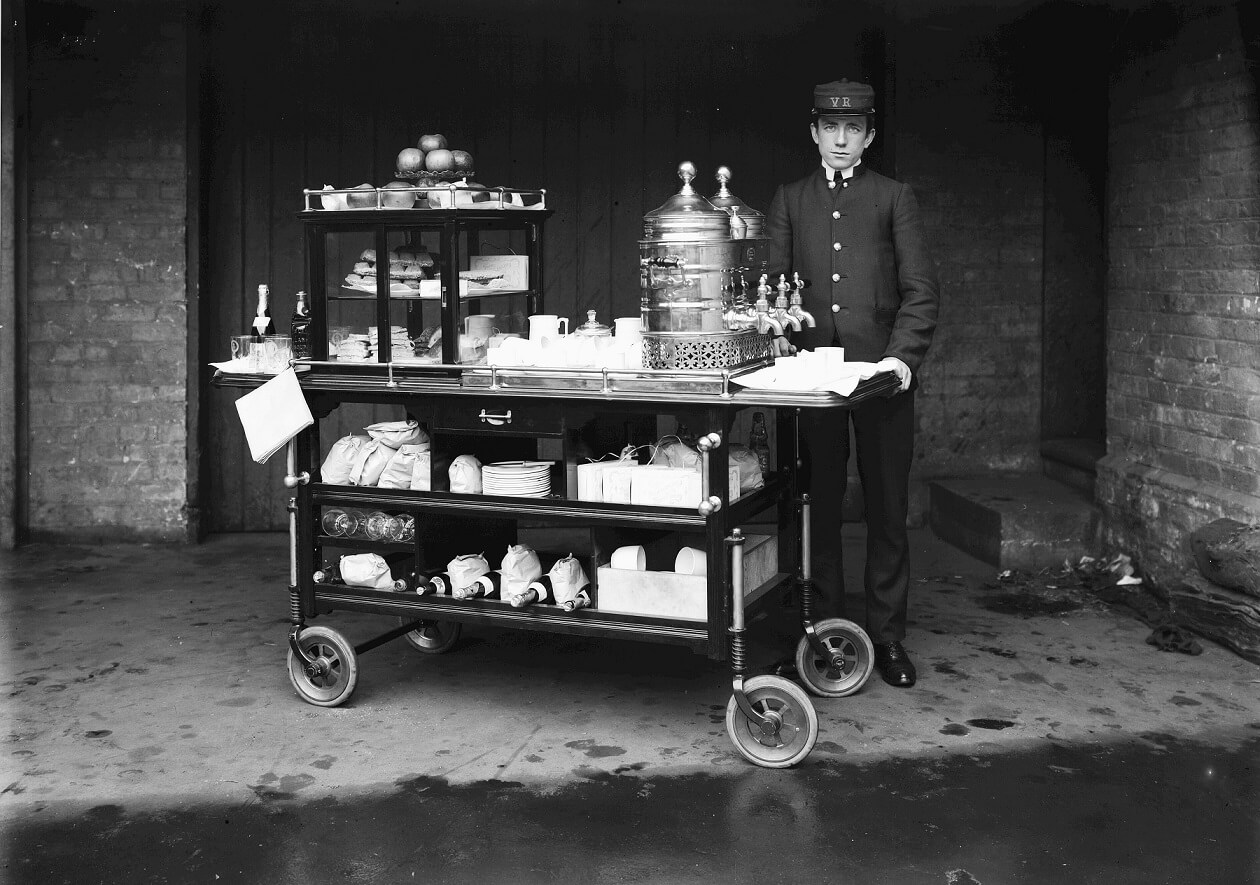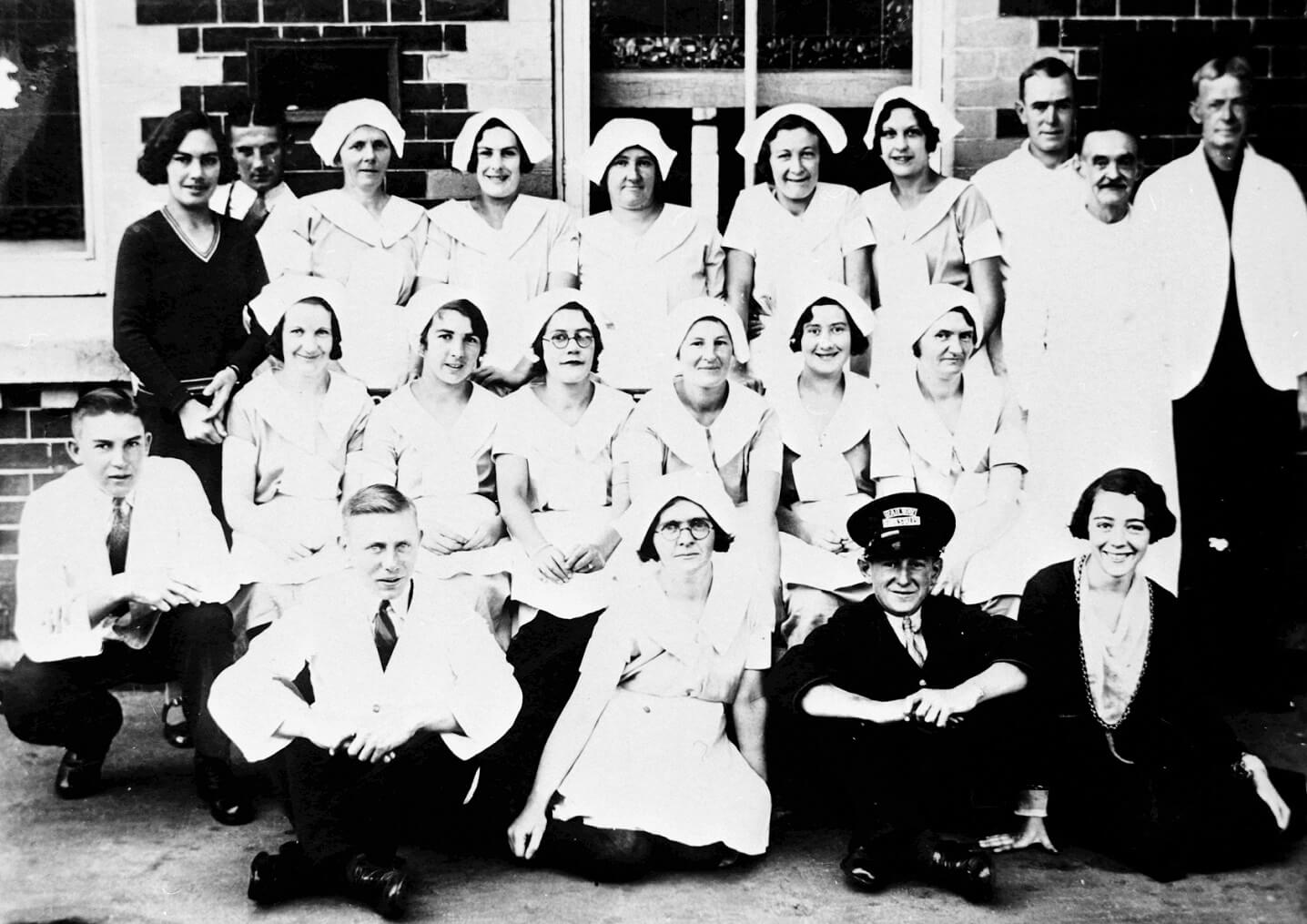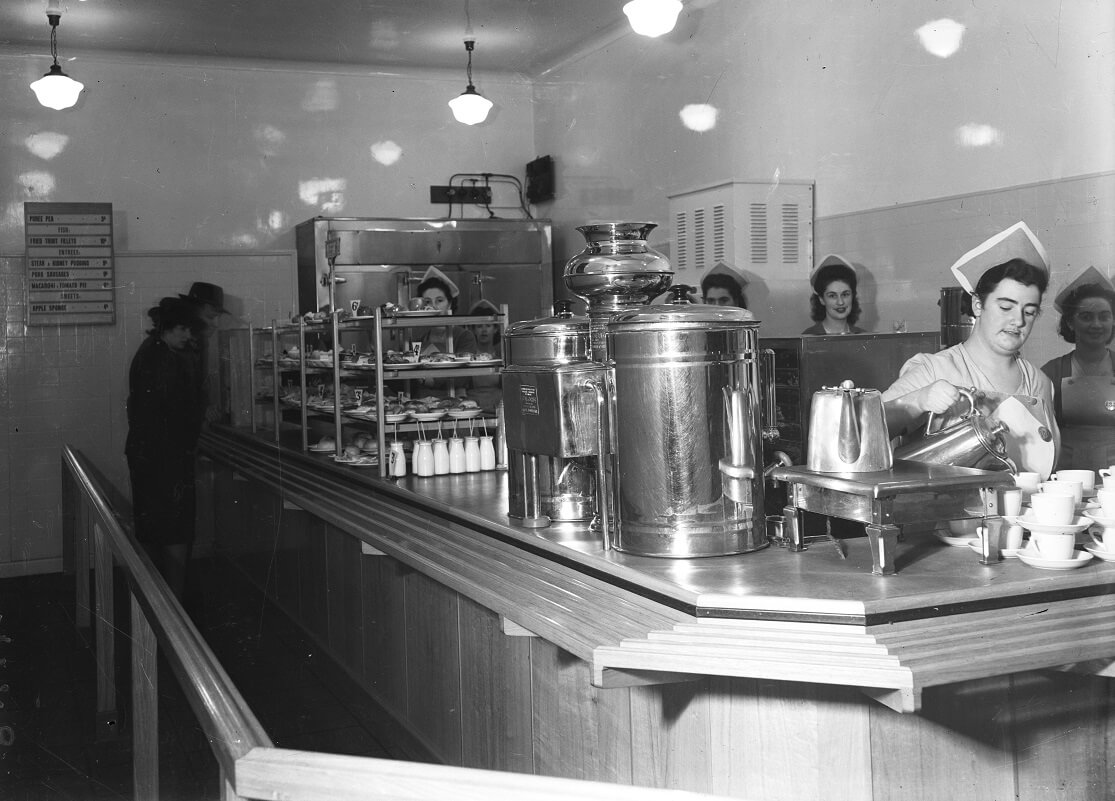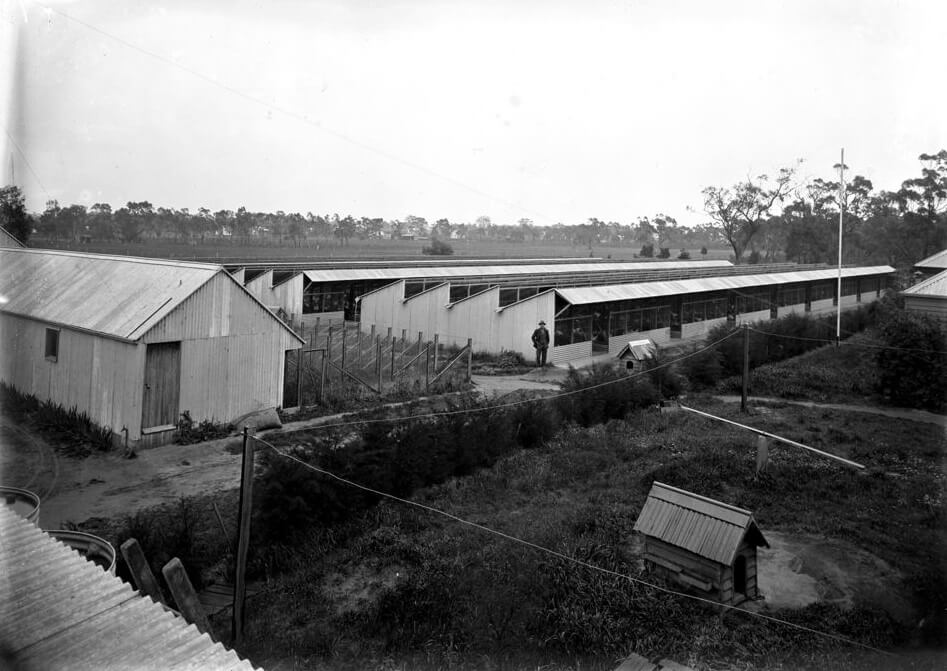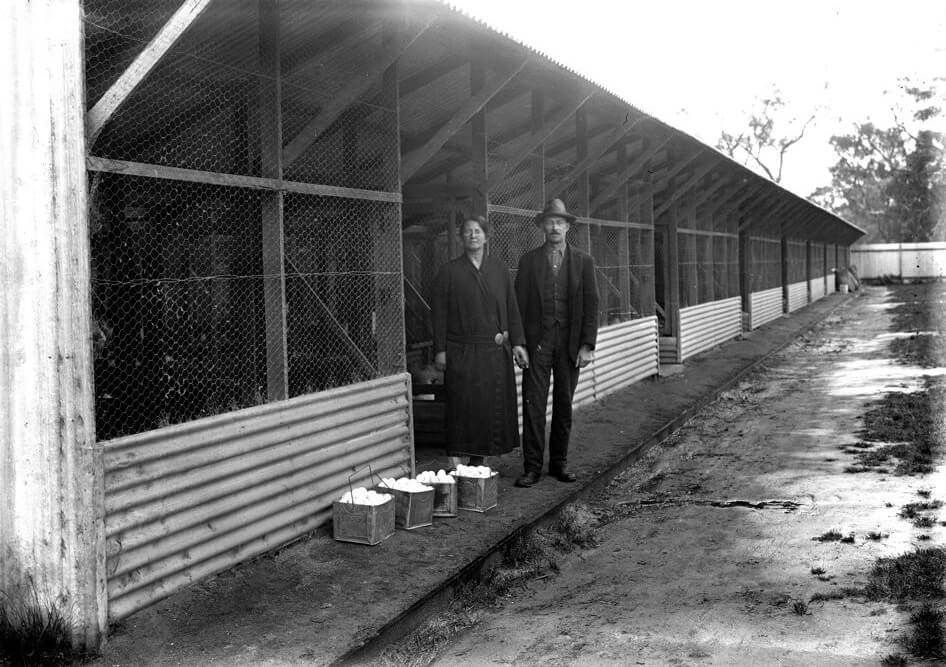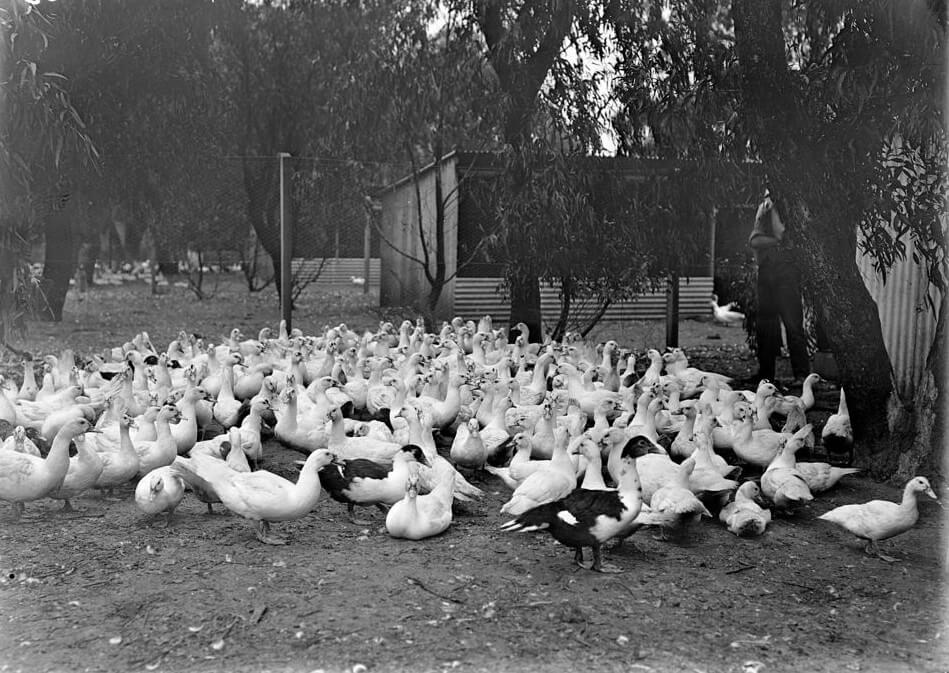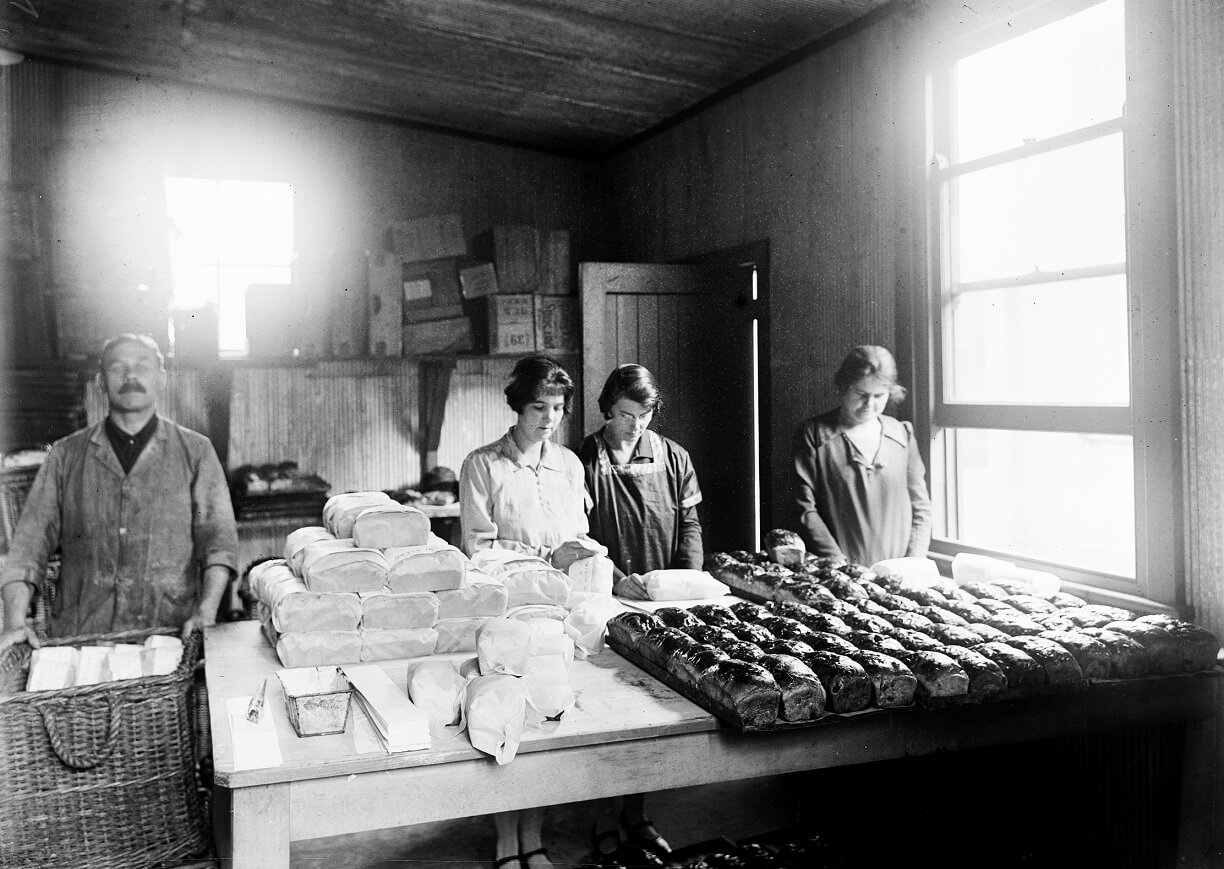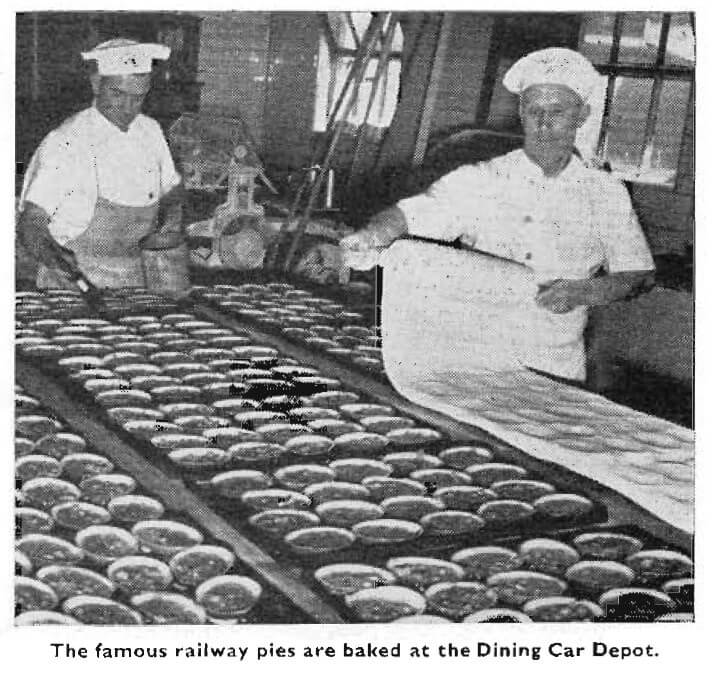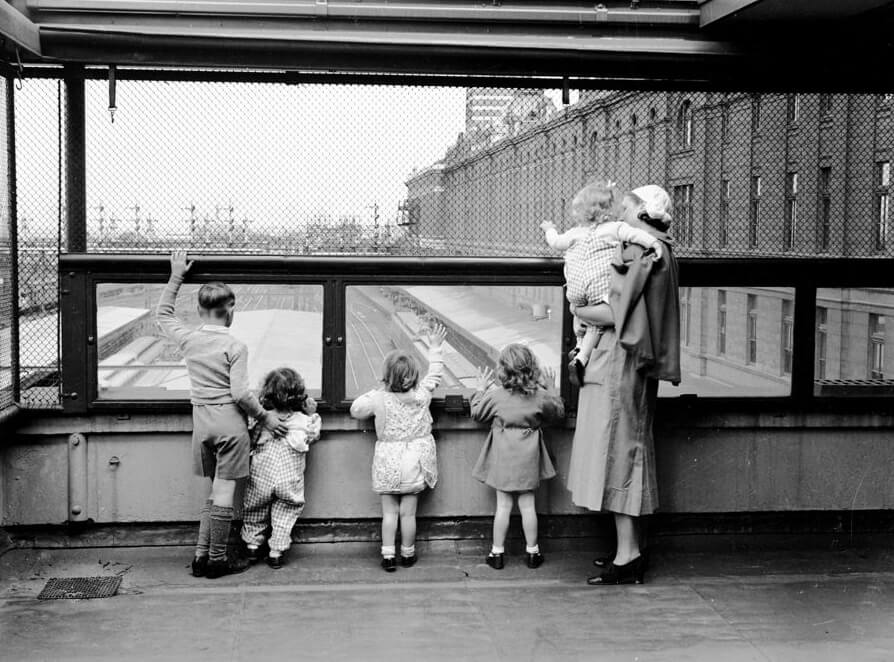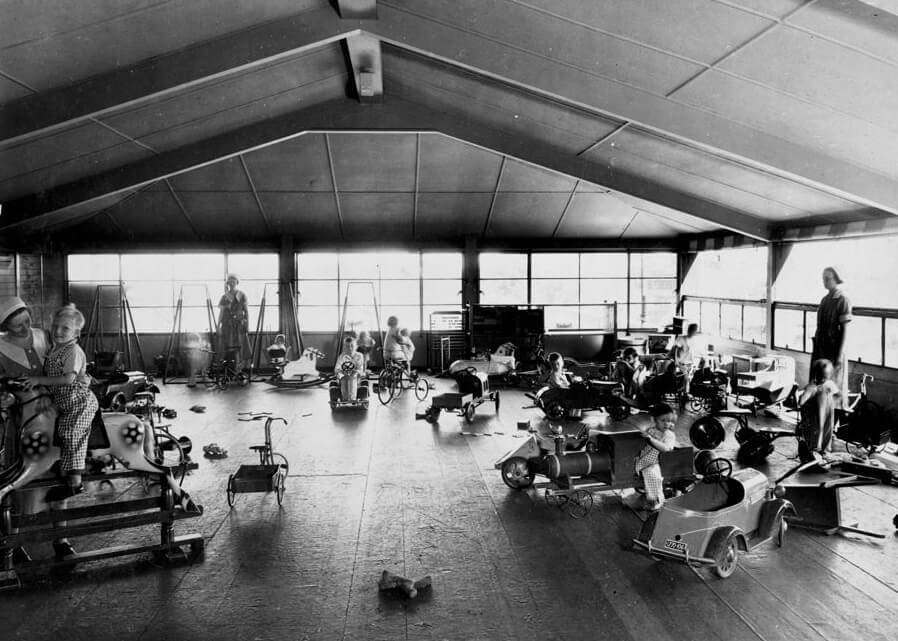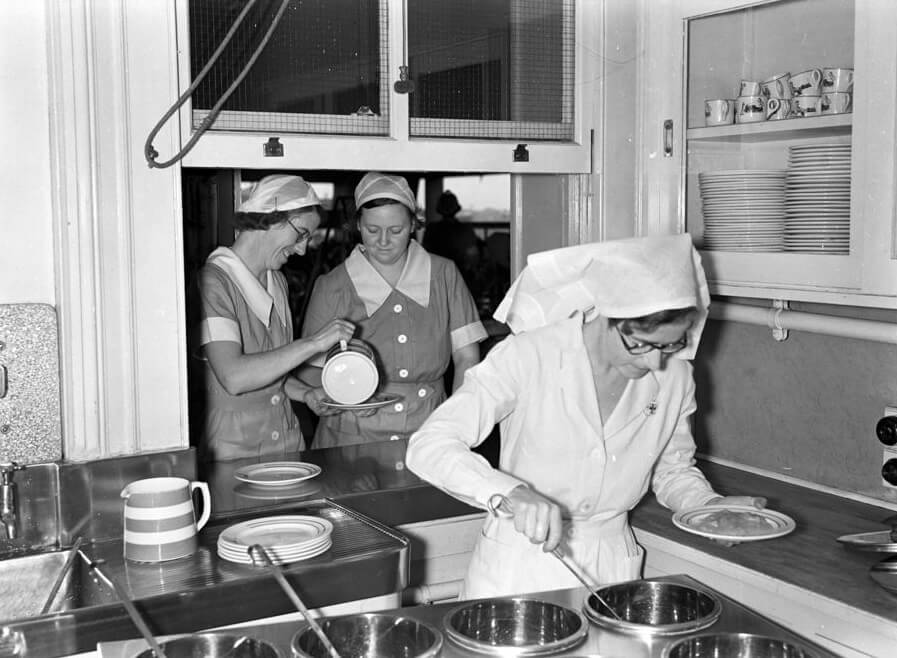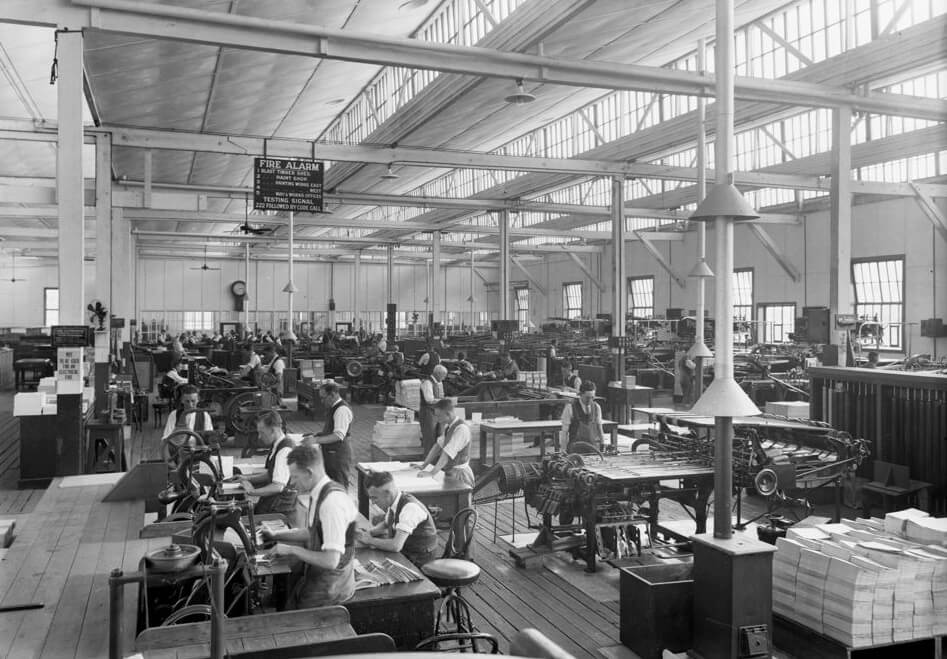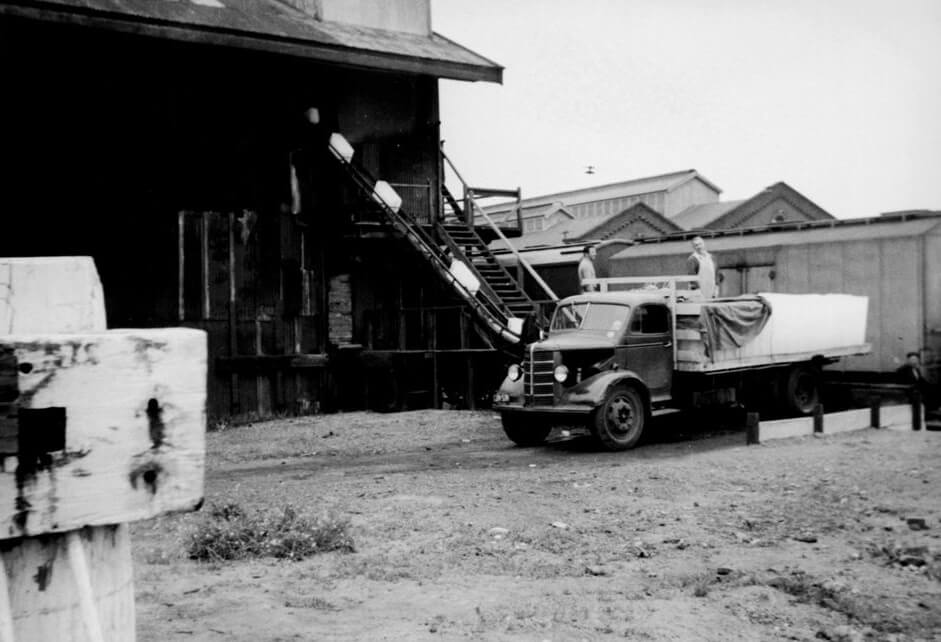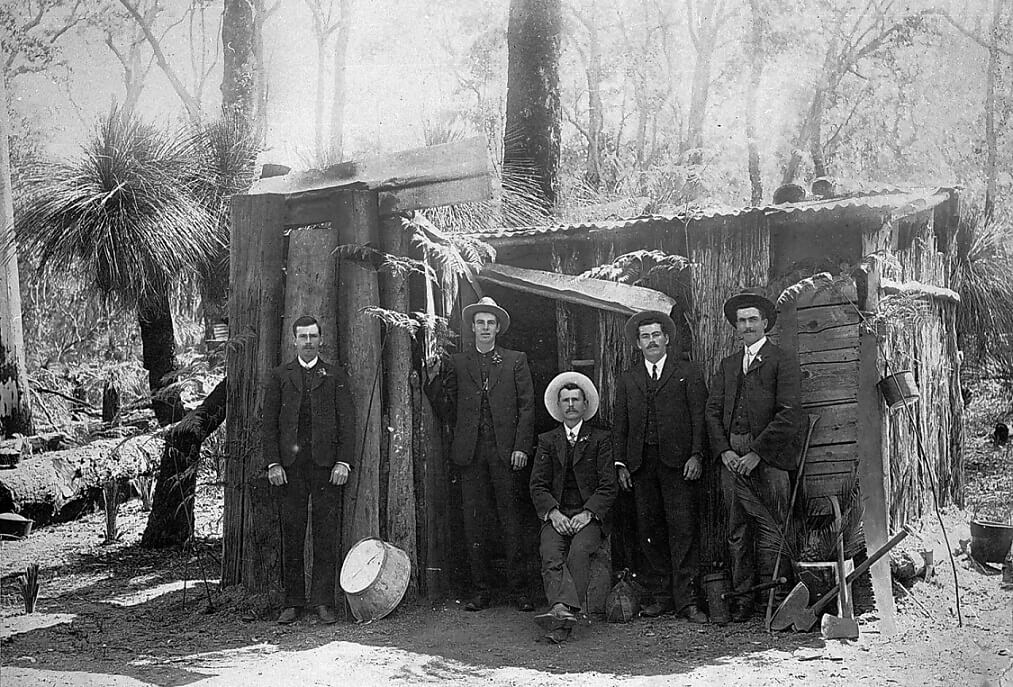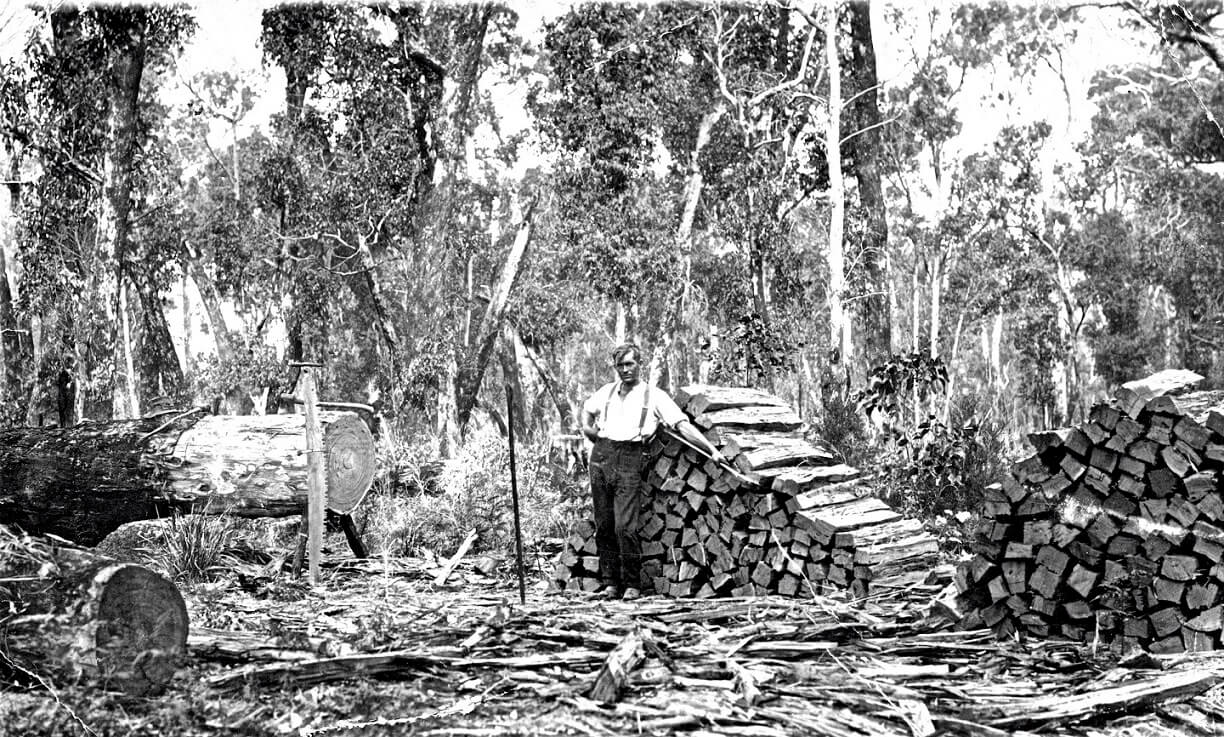Everything is done to make the services provided by the Victorian Railways as self-contained as possible.
By the early-twentieth century Victorian Railways was virtually self-sufficient. As historian Thomas Yates points out:
Not only did its 30,000 employees run the rail network, they also provided most of its supporting goods and services. Victorian Railways’ engineering offices designed and built stations, bridges and freight depots; its workshops manufactured locomotives, carriages, and office furniture; its power station supplied the suburban electric train system.
Few services or goods were outsourced. A railway-owned printing works stamped out tickets and produced stationary for government departments. There was even a butchery, bakery and poultry farm producing food for the hundreds of refreshment rooms in stations across the state. Few of these functions remain today.
The Refreshment Services Branch was established in 1920 by the railway’s Chief Commissioner, Harold Clapp. The Branch took over management of all refreshment rooms at country stations, and the dining and buffet cars on trains. (Prior to this, all refreshment services had been provided by private contractors.) Later, the Branch expanded to include a laundry service, operation of a hairdressing salon, a bakery, butchery, poultry farm, and the management of the chalet guesthouse at Mt Buffalo. By 1926, only 6 years after it was established, there were 61 refreshment rooms across the state. The Branch employed 770 employees, 460 of whom were women.
Most refreshment rooms closed in the 1970s. Faster trains, less stops, declining passenger numbers and the introduction of buffet cars on trains all contributed to their demise.
3,250,000 MEALS: Railway Refreshment Rooms
Self-Contained Service
So far as is practicable the Victorian Railways Refreshment Services branch has been made absolutely self-contained. In addition to the actual business of supplying meals to patrons, it runs a laundry, where all the necessary work of the department is done, a butchery at West Melbourne and a poultry farm at Noble Park.
The ramifications of the department extend throughout the State. There are 61 refreshment rooms, of which 41 are staffed by managers under the direction of the branch. The leased rooms are mostly tea stalls doing small and intermittent business. They are conducted by local residents. However leased as well as staff rooms are subject to frequent and regular inspection to see that the prescribed standard of service is maintained.
During the year the catering section supplies about 3,250,000 meals or separate serves of tea, coffee or food. To do this enormous quantities of comestibles are used.
Every month about 33 tons of meat, 1 ½ ton of ham and one ton of bacon are consumed. This does not take into account the large numbers of turkeys, ducks and chickens which also figure in the domestic economy of the branch.
The magnitude of the quarter-master’s job in the department may be gauged from the fact that last year nearly £30,000 was spent on meat alone. Most of this meat is purchased in bulk and cut up at the department’s butchery, whence it is sent to the different refreshment rooms.
MOTTO OF “SERVICE”
Slogans and the railway service have become almost synonymous terms in recent years, and the refreshment branch has adopted the motto of an American corporation which controls a chain of huge hotels: “Service in order to obtain satisfied guests”. This corporation believes that the business of selling hospitality is a matter of loyalty, of honesty, of character, of consideration, and of a willingness to serve, and that its chief asset is the spirit of “we must give to get”.
The Railways Refreshment Services branch has adopted the same ideal. It sells service in small quantities, and the officers say they are content to be judged by the quality of that service. Many compliments have been paid to the branch by experienced interstate and overseas travellers, but the department realises that improvement is always possible, and desirable. Therefore it strives for ever greater efficiency and for a daily improvement in the service.
480,000 EGGS
Forty thousand dozen eggs are used by the department every year. Mostly they are produced at the Noble Park poultry farm. Bread also is a formidable item in the menu. The monthly consumption is about 21 ½ tons. To go with the bread four tons of butter are required.
In the way of vegetables the department does not stint its patrons. It provides everything in season, and large quantities of green vegetables are required. However, the heaviest expenditure in this direction is incurred in the purchase of potatoes, of which 29 tons have to be peeled every month.
The quantities of tea and coffee used would provide a nice side line for a grocer if he could secure the trade at retail rates as an addition to his business. Every year the department uses about 14 tons of tea and eight tons of coffee. Then comes the necessity for sugar, of which more than seven tons a month is used, and for milk, the consumption of which is 7000 gallons a month.
WELFARE WORK
The 3,250,000 meals mentioned earlier does not include those supplied at the Newport workshops, where 900 employees daily enjoy a hot three-course luncheon. This department is portion of the welfare work of the Railways Commissioners, and will be extended next week, when a new dining room of similar type will be opened at North Melbourne for the convenience of the 2000 employees working in the district.
The department also controls the liquor bars, and the fruit, tobacco and confectionery stalls, all of which have large sales.
In all the department has 770 employees, 460 of whom are women. They are drawn from all portions of the State.
The Herald, 9 October 1926. Reproduced courtesy National Library of Australia.
Substantial numbers of women were employed in the Refreshment Services Branch — as waitresses, barmaids, laundresses and, in the smaller dining halls, as cooks.
Maryborough refreshment rooms, unknown date but probably c.1890
Reproduced courtesy Public Record Office Victoria
Refreshment rooms at Victorian railway stations were set up in the late-nineteenth century, leased to private operators. The quality of service and food was often criticised. The following letter was published in The Argus newspaper in September 1884:
RAILWAY REFRESHMENT-ROOMS.
TO THE EDITOR OF THE ARGUS.
Sir, — Some few months ago, when tenders were called for leasing the railway refreshment rooms, the travelling public were promised all sorts of improvements, the cooking was to be perfect, the food of the best quality and of greater variety, and the charges more moderate, consequently we were all looking forward with pleasure to the time when these improvements would take place. Well, Sir, they have now been in force over two months, and as a constant traveller I have no hesitation in stating that with few exceptions the cooking, food, variety of same, and charges are very much worse than they have been during the past five years, and this owing to the absurd system of letting to the highest tenderer without any inquiry as to his fitness for the position, or his ability to pay such sum with profit to himself and at the same time faithfully and honourably supply the public.
The present bill of fare has been so absurdly framed that it allows the lessees to legally rob the public in the most barefaced manner, as the following cases that have come under my personal notice will prove:—
A lady and two children seated themselves at the table and asked for three cups of coffee and three meat pies. On asking what she had to pay she was informed 4s. 6d. The lady said surely there must be some mistake, whereupon the waitress asked the lessee, who stated 1s. 6d. each was the correct price, as they had sat at the table. Now, Sir, I should like to know by what law they are allowed to charge 1s. 6d at the table for what they only charge 6d. at the counter, where the same amount of crockery and cutlery would have been used.
Another case was where a gentleman sat down to table, and having had some half-cold and very watery soup, asked for roast beef or steak, but was informed there was only chops and sausages. He was then supplied with two sausages and two potatoes for which he had to pay 1s. 6d. and this at one of the principal stations. I am sure the proprietor of any cheap eating-house in Melbourne would blush at putting such a meal before a customer and charging 6d. for it.
That such a state of things should be in existence while there is a well-paid inspector is a disgrace to any Government, and the sooner the travelling public insist upon the commissioners making an alteration the better.
The Refreshment Services Branch took over management of all railway refreshment rooms in the 1920s. Service, and the quality of food, improved.
Facilities offered by the Refreshment Services Branch ranged from elaborate dining rooms at country railway stations, to catering carts such as this.
Refreshment cart, unknown date
Reproduced courtesy Public Record Office Victoria
Seymour Refreshment Room staff, unknown date but probably c.1930
Reproduced courtesy Public Record Office Victoria, VPRS 12800/P1, item H 4801
The refreshment rooms at Seymour opened in 1872, becoming the largest country refreshment room in the state. There were separate buffet and dining rooms and, at its peak, 34 staff were employed. The buffet room had a C-shaped serving counter 40 metres long which could accommodate 100 passengers at a time.
After 1976, only light refreshments were served and the rooms closed in 1981.
Refreshment cafeteria, unknown station, no date but probably c.1935
Reproduced courtesy Public Record Office Victoria
Victorian Railways poultry farm, c.1940
Reproduced courtesy Public Record Office Victoria
The refreshment rooms required a constant supply of eggs. The railway poultry farm was established in 1922 by Commissioner Harold Clapp on ten acres of land at Noble Park. At its peak it housed 8,000 fowls. Fresh eggs were collected twice daily and transported to the Noble Park railway station. The farm also reared ducks and grew vegetables for use by the railways. Oats, barley and maize for feed were grown on the farm.
The eggs were supplied to railway refreshment rooms across the state, dining carriages and to the Mt Buffalo Chalet. Any surplus summer production was preserved by smearing the eggs with a product called Keepeg, allowing them to be stored without refrigeration. Before winter the chalet at Mt Buffalo was well-stocked with the preserved eggs, in case snowfalls prevented fresh supplies getting through. The farm closed in June 1970 and the land was sold.
Farm Managers, Victorian Railways poultry farm, no date but probably c.1940s
Reproduced courtesy Public Record Office Victoria
Ducks at the Victorian Railways poultry farm, c.1950
Reproduced courtesy Public Record Office Victoria
… on hooks around the cutting room, hang rows of prime carcases. In the adjoining room the sausage-making plant churns out about 1¼ miles of sausages a day for use in the various Refreshment Rooms. Over in the corner, beef floats in brine tubs, being transformed to corned beef. The freezing chambers behind the shop hold bulk meat supplies and dishes of “smalls” – tripe, ox-cheek, kidneys, frys and brains.
‘Behind the Railway Scene’, publicity brochure published by Victorian Railways, 1950
All meat sold in the railway’s refreshment rooms was supplied by the Railway Butchery, established in 1922 at the Dining Car Depot at the back of the carriage sheds in Spencer and Dudley streets. In 1976 the butchery ceased operation and meat was bought pre-cut and pre-packaged.
Victorian Railways Bakery, c. 1930s
Reproduced courtesy Public Record Office Victoria
VPRS 12903/P1, item 068/02
In 1923 Commissioner Clapp established the Railway Bakery to supply fresh-baked goods for the refreshment rooms and dining cars. It was no small enterprise. In 1957/58, the bakery produced 4,005 dozen apple pies, 12,480 pounds (approximately 6,000 kgs) of block cakes, 12,725 dozen pasties, 64,232 dozen pies, 16,258 dozen queen cakes, 9,465 dozen scones, 6,727 dozen sultana luncheon, 8,311 dozen wholemeal cakes and 13,212 dozen yeast buns. The bakery closed in 1974.
… the famous ‘Railway pies’ come from the Bakery, where a foreman Baker (who holds? the D.C.M., M.M. and Bar from the First World War) and a team of pastrycooks work busily, looking most professional in their white hats and white suits. Pies baked here are distributed to Refreshment Rooms all over the State. The Bakery works three shifts in the 24 hours, and has turned out as many as 830 dozen pies, 210 lb. of fruit cake and 350 dozen small cakes in a single day. The huge “Scotch” oven cooks 50 dozen pies in a batch.
‘Behind the Railway Scene’, publicity brochure published by Victorian Railways, 1950
Commissioner Clapp then turned his attention to childcare. A Children’s Nursey was established at Flinders Street Station in 1933, the first of its kind in the southern hemisphere. The Argus reported:
NURSERY FOR BABIES
RAILWAYS INNOVATION
Arrangements have been made by the Railways department to equip a modern nursery on the second floor of the Flinders street station buildings, where mothers who travel by train may leave their babies and children in the care of a qualified and experienced nursing sister and staff while shopping in the city.
The nursery will be opened to-day. It will comprise three rooms – a cotroom with cots for babies, a playroom with rocking-horse, toys, and other attractions for older children, and a third room where milk will be heated and food prepared at the direction of the mother, for which a nominal charge will be made.
Unsplinterable glass windows, special nursery and kindergarten decorations and playthings, central heating and ample daylight and fresh air ventilation are features of the nursery.
Charges for the use of the nursery will be:-
One hour, 6d.: each additional hour, 3d.:
maximum charge, 2/- a day.
The nursery will be open from 9 a.m. to 6.15 p.m. Mondays to Thursdays, 9 a.m. to 9 p.m. Fridays, 9 a.m. to 1.15 p.m. Saturdays.
Sister M. Northcott will be in charge. She will be assisted by a registered infant welfare nurse with experience in the care of children.
The nursery may be reached by lifts at the entrance to the station buildings in Flinders Street nearest Swanston Street and opposite the Electricity Commission’s building. Free cloakroom facilities will be available for the prams.
The railway nursery, ‘open-air playground’, c.1930. The open-air playground was opened in 1926. According to historian, Jenny Davies, the playground was notable for its special safety precautions. Sliding roof panels and sun-blinds provided shade from the sun and shelter from the wind and rain. The windows were of unbreakable glass with a chain wire guard of small mesh above the windows to prevent children climbing out. Children could watch the trains go by.
Reproduced courtesy Public Record Office Victoria
The Nursery was managed by the Refreshment Services Branch and was immensely popular. Only one year after opening, it was extended to include two playrooms, three cot rooms, a kitchen and reception area. Staff consisted of an infant welfare sister and three qualified mothercraft nurses.
Mothers were encouraged to leave their children in the care of railway’s staff while they shopped in the city. Many took advantage of this early form of creche and, by the end of 1937, more than 54,000 children had been cared for.
According to Davies, the Nursery closed in January 1942, ‘allegedly because of war precautions and restrictions relating to the gathering of people which prohibited such activities.’ However, as Davies explains in her published history of Flinders Street Station:
Mavis Cleverdon, a mothercraft nurse at the time, suggests that there were other reasons why the nursery never reopened. Both Commissioner Clapp and Sister Northcott retired in 1939. It was well-known that the nursery was ‘Clapp’s baby’, an initiative he was extremely proud of, and that Sister Northcott had the necessary combination of skills, experience and temperament to make it work…
A newspaper report of June 1946 headed ‘Gone with the War’, stated that the commissioners had no intention of reopening the nursery as the space was now used for offices. Although acknowledging that it was difficult for mothers to find minders for their children, the railways could no longer provide this service.
Major extensions took place at the Nursery in the late 1930s. A glassed-in office was built for the sister-in-charge, and a mothers’ room, where mothers could change their children from ‘street attire to romping clothes’. The number of cot rooms increased from three to four and all rooms were soundproofed.
A new playroom, seen above, was built and included two bird aviaries and a fish tank. A 1938 brochure promoting the nursery explained the appeal:
Flitting about in their natural setting of trees and foliage, or resting snugly in their nests, the many birds delight the children. In the glass-fronted fish tank, the constant movements of the fish also arouse the wide-eyed admiration of the children.
There were swings for the small children, and tricycles, scooters, wheelbarrows, toy trains and cars for the older children to play on.
A kitchen with modern sterilising equipment was part of the nursery. ‘Lady Talbot Milk’ was available for pre-purchase for 2d and orange juice for 3d. Food could also be pre-purchased for the children. A full roast meal, with a cup of milk and stewed apple was 10d.
According to Davies, the woman serving the food in this picture is probably the dietician, Miss Wilmont, a qualified nurse. Part of her role was to test recipes used by the Refreshment Services Branch which managed the nursery.
Victorian Railways Printing Works, North Melbourne, c. 1910
Reproduced courtesy Public Record Office Victoria
Have you ever wondered where all the railway tickets come from, or who prints the time-tables, the posters on stations, or the folders and pamphlets that are handed out at the Victorian Government Tourist Bureau? Well, it’s all part of the work done behind the railway scene. The Railway Printing Works at North Melbourne are responsible for it all. Their job is to tell the story in print.
‘Behind the railway scene’, publicity brochure printed by Victorian Railways, 1950
The Victorian Railways Printing Works (VR Print) at North Melbourne spread over half an acre, employing 120 staff, including typesetters, compositors, bookbinders, mechanics, storemen, packers and cleaners. In the 1950s about 2 million separate pieces of publicity, including booklets, folders, handbills, leaflets and posters, were printed each year. About 80 million train tickets were printed as well. The printing works closed on 21 December 1990.
Railwaymen make… Ice!
Of the 500-odd occupations filled by railway men and women, making ice is among the most unusual. The Railway Ice Works, on the fringe of the Melbourne Yards, produce about 3,300 tons of ice between September and April each year, for use in the 417 refrigerated “T” trucks. During half a century they have played their part in making a much appreciated service available to railway patrons.
Iced “T” trucks are used principally to carry butter, cheese and meat, but they are also invaluable when export fruit is to be moved from cool stores to ships.
The Ice Works men make the ice, clean the “T” trucks thoroughly, and load the ice into the storage bins. It is a 7-day a week job, with 30 trucks a normal day’s work. As many as 88 trucks have been got away in one day. This record performance was put up during the 1946 fruit season when the “ice men” worked from 8a.m. to midnight, despite pouring rain. They are rightly proud of that effort.
Ice is made in long moulds which are filled with water and frozen in brine by carbon dioxide. Each “batch” takes about 16 hours.
When frozen, the blocks are taken up by lift? into the store-room, where 120 tons are always held as reserve against plant breakdown. However, good maintenance ensures that breakdowns are rare, and once the machines have been started, they can be relied on to run for 24 hours daily during the whole season, with never a stop.
‘Behind the railway scene’, publicity brochure printed by Victorian Railways, 1950
Loading ice into the storeroom at the Melbourne Yards, c.1950
Reproduced courtesy Public Record Office Victoria
In the heyday of Victoria’s railway construction, from the 1880s into the 1930s, hundreds of men were employed either hewing (cutting) sleepers or delivering them to railway stations. Timber sleepers were needed for new railway lines, maintenance and upgrades. Every kilometre of railway required, on average, about 1,900 sleepers.
Shaping sleepers with hand tools — a crosscut saw, broad axe, and wedge — was backbreaking work for scant financial reward. The cutter would fell the tree with an axe, debark it, split it with steel wedges, saw it to length and shape it with a broad axe. In the early 1900s, cutters earned nine pence per sleeper, barely making the basic wage.
Cutters often lived in bark huts or tents in the bush, sharing their camps with their families and other workers. There was constant danger from snakes and ‘widow makers’ (falling branches). Manual harvesting of sleepers ended in the 1960s with the introduction of machines such as swing saws.
A group of sleeper cutters outside their slab hut, Lucknow, Victoria, 1908
Reproduced courtesy Museum Victoria
Mick Perrin, sleeper cutter, Gippsland, Victoria, c. 1940
Reproduced Mansfield Historical Society
The old way of cutting sleepers with a broad axe, that’s gone. It’s all sawn with mechanical saws now. Over the years it slowly changed, then it finished, thank God! It was a slave industry.
-Forester, Denis Christopher

